

Finland and AI: Strengths, Challenges and Opportunities
Finland is a forerunner in AI research and application, but continued success is by no means guaranteed. Amid the technological upheaval, Finland stands out for its digital skills, high-quality research, and robust infrastructure.
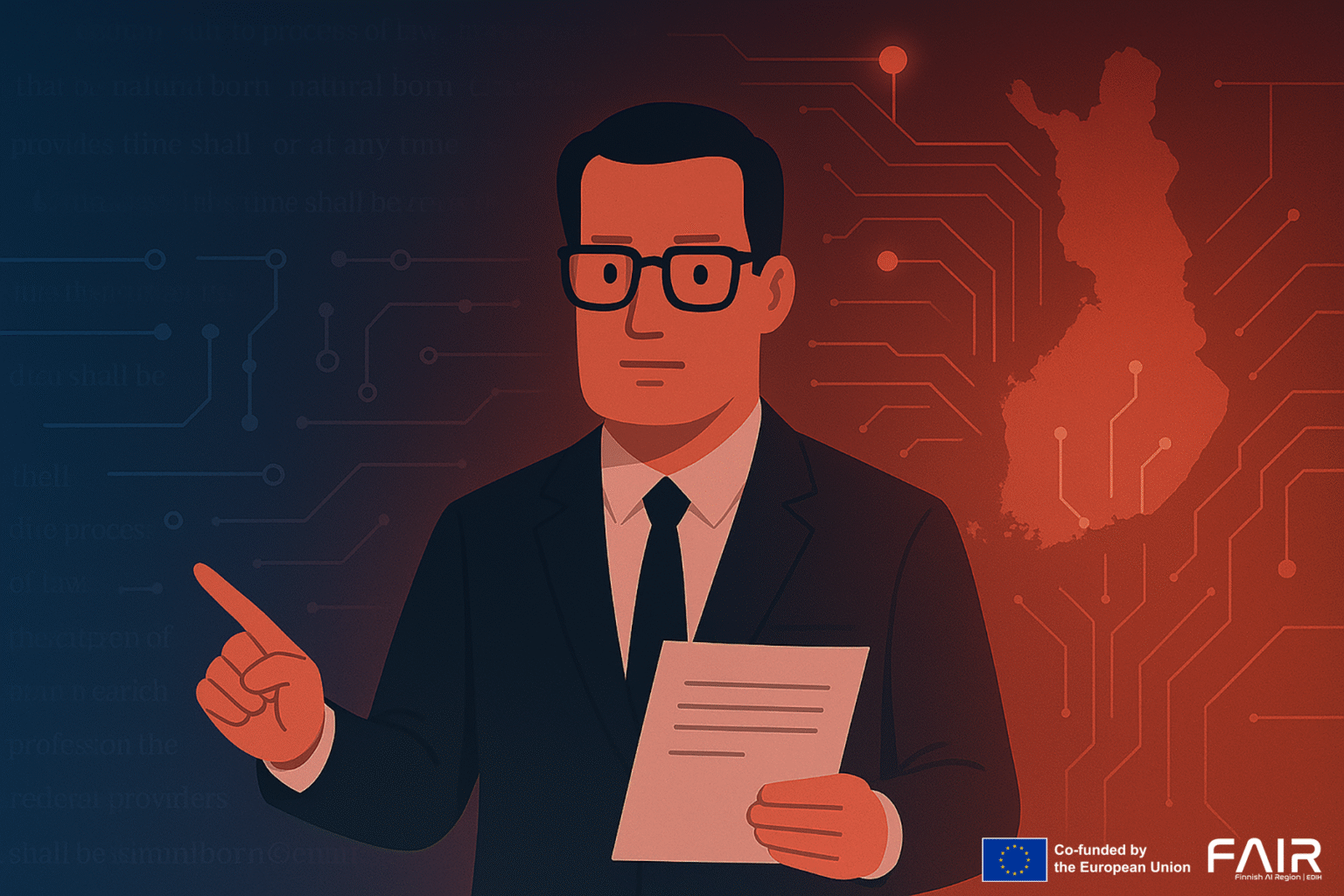
Text: Martti Asikainen, 17.7.2025.

Introduction
Humanity is living through a historic technological transformation, where artificial intelligence is no longer merely a promise of the future, but part of today’s reality. It is fundamentally changing economies, societies and power structures. AI also opens up new opportunities for Finland to establish its profile both in Europe and globally.
The signs are promising. Finland has consistently ranked amongst the best European countries in measurements of corporate AI adoption (Eurostat 2025a). The Finnish AI ecosystem is exceptionally dynamic and diverse for its size, enabling the country to succeed in international comparisons.
Finnish companies are amongst the most active in Europe in providing information and communication technology skills training to their staff. They purchase the most cloud services and employ the third-highest number of ICT specialists relative to population size (Eurostat 2025b; Eurostat 2025c; Eurostat 2025d). According to Eurostat research, Finns also have the second-best basic or better digital skills in Europe (2024).
In Stanford University’s Human-Centered AI Institute’s 2024 AI Global Vibrancy Ranking, which measures AI vitality, Finland was the world’s fifth most vibrant AI country relative to its population in 2023 (HAI 2024). The classification is based on over 40 indicators, including published research, foundation model development, workforce diversity, computational power and legislation.
From Pioneer Work to Investment Challenges
This development is no accident. Behind it lies the country’s long history with AI research, which traces its roots to the pioneering work of Seppo Linnainmaa and Teuvo Kohonen in the 1970s (Sarlin 2025). Finland has also been an active pioneer in AI policy in Europe. It created the world’s first national AI strategy in 2017, which was updated in 2020 (European Commission 2021).
The Finnish government’s aim was to create substantial measures driven by the AI strategy, targeting a place amongst the leading AI countries on the global stage. Since then, the country has adopted an open data policy and sought to create favourable conditions for:
- Enhancing the competitiveness of business and industry
- Providing high-quality public services
- Improving public sector efficiency
- Ensuring a functioning society and welfare
However, challenges abound. According to The Nordic State of AI report, the challenge for AI-dependent companies in Finland has shifted from the skills shortage of previous years to insufficient investment (AMD Silo AI & AI Finland 2025). This change reflects the maturation of Finland’s AI ecosystem, where the basic elements are in place and the focus has shifted from process optimisation towards strategic implementation.
Businesses using AI technologies, 2024 (as % of businesses)
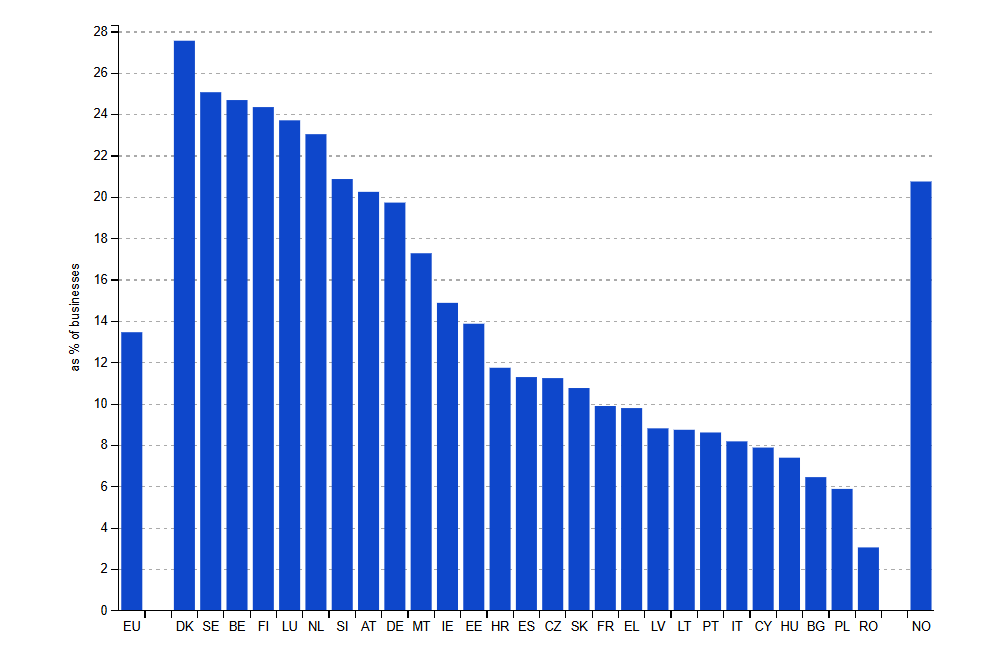
Source: Eurostat – AI by size class of enterprise (2025a)
People with basic (or better) digital skills (as % of people)
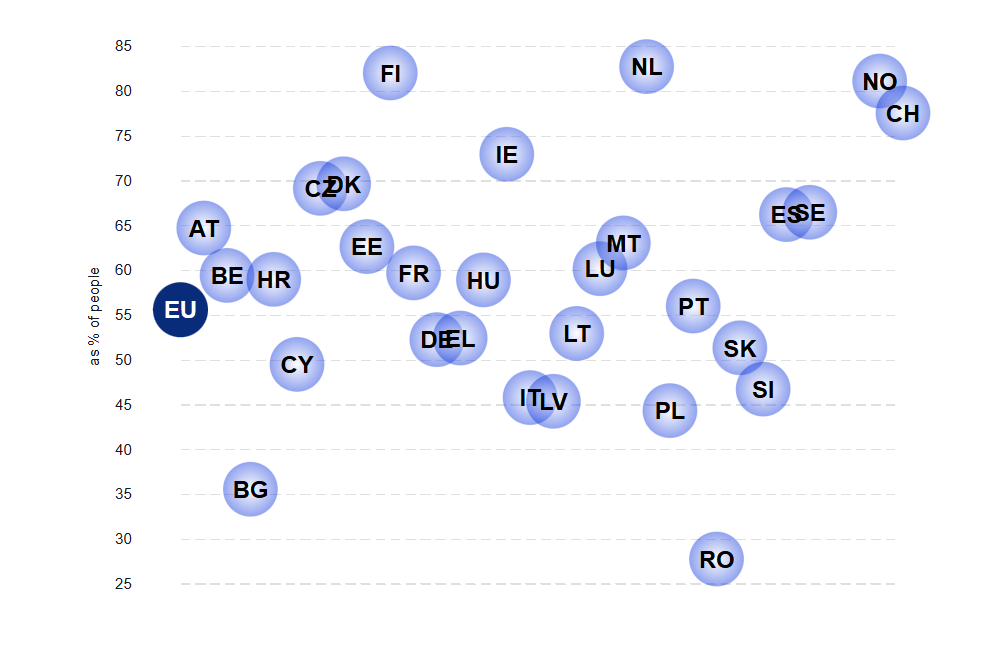
Source: Eurostat – Individuals’ level of digital skills (2024)
The Foundation of Finland's Strengths
Finland’s international indicators suggest that the country has particularly good starting conditions for the technological race. Finland possesses deep expertise in several critical technology areas that form the foundation of digital societies.
Critical technology areas have been defined as a key part of the EU’s economic security strategy. The aim is to strengthen economic resilience and maintain and grow the EU’s technological competitive advantage (Kristeri 2025).
Critical technology areas include:
- Advanced semiconductor technologies
- AI technologies
- Quantum technologies
- Biotechnologies
- Advanced connectivity, navigation and digital technologies
- Advanced sensor technologies
- Space and propulsion technologies
- Energy technologies
- Robotics and autonomous systems
- Advanced materials, manufacturing and recycling technologies
According to the 2025 joint publication “Critical Digital Tech from Finland: Driving Growth and Security in Europe”, Finland holds the keys to potentially becoming even the EU’s leading country in developing and applying critical digital technologies. Finland possesses exceptional expertise in AI, high-performance computing, space and quantum technologies, semiconductors, telecommunications (particularly 6G) and cybersecurity, which supports the EU’s strategic objectives (Sitra et al. 2025).
Business and industry indicators also confirm Finland’s strong position in emerging and critical technologies. Measured by the digitalisation level of companies with over ten employees, Finland is the EU’s number one, followed by Denmark and Sweden (Eurostat 2025a). In innovation surveys examining AI adoption, Finnish firms have consistently placed at the top of the rankings (Eurostat 2025e).
Digital intensity level in businesses, 2024 (as % of total businesses)
Integrating digital technologies into various areas of business enables companies to enhance their products and services, as well as strengthen their competitiveness. The digital intensity of businesses is monitored by the Digital Intensity Index (DII), which measures the use of 12 different digital technologies by businesses, for example using AI or making e-sales.
The index scores businesses depending on how many digital technologies they use:
0-3: very low
4-6: low
7-9: high
10-12: very high
Total Businesses (EU)
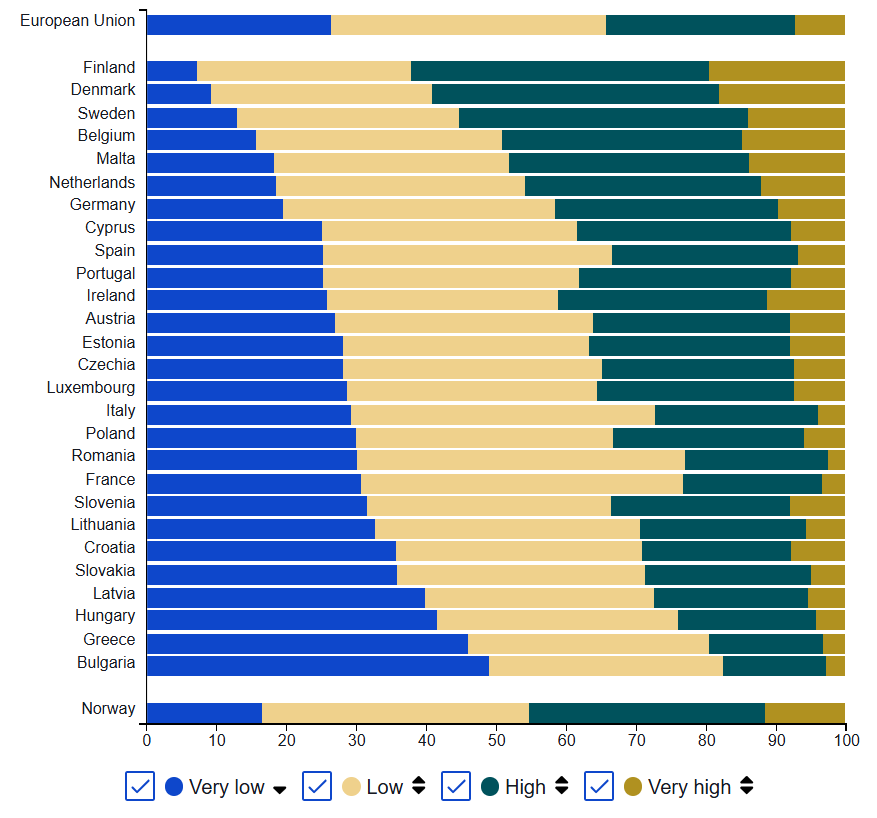
SMEs (EU)
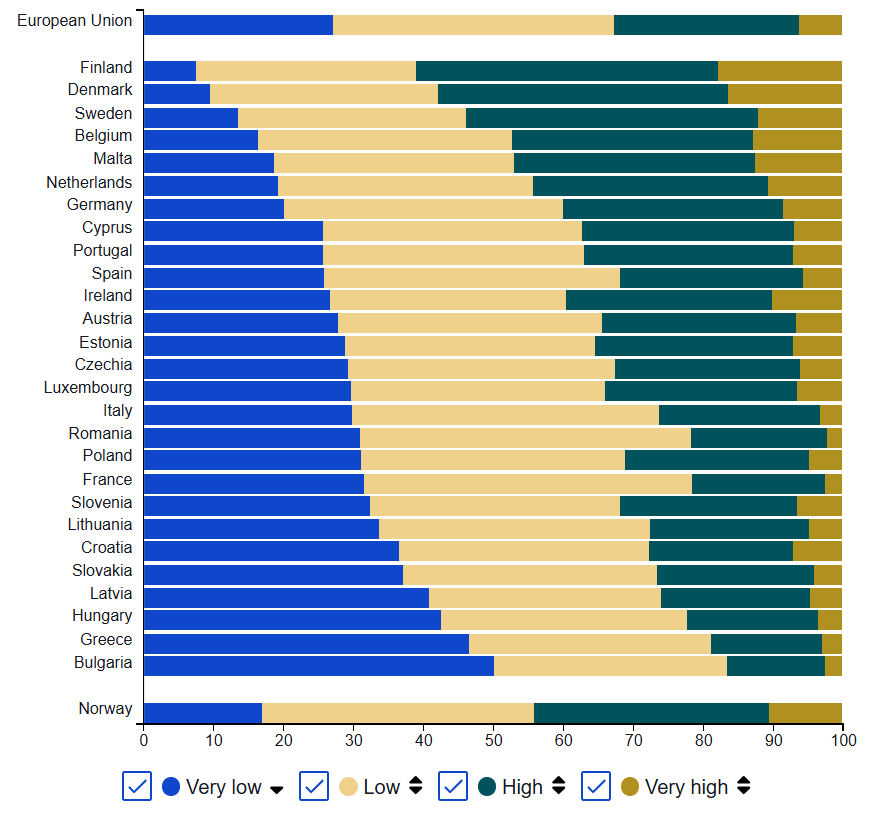
Large Businesses (EU)
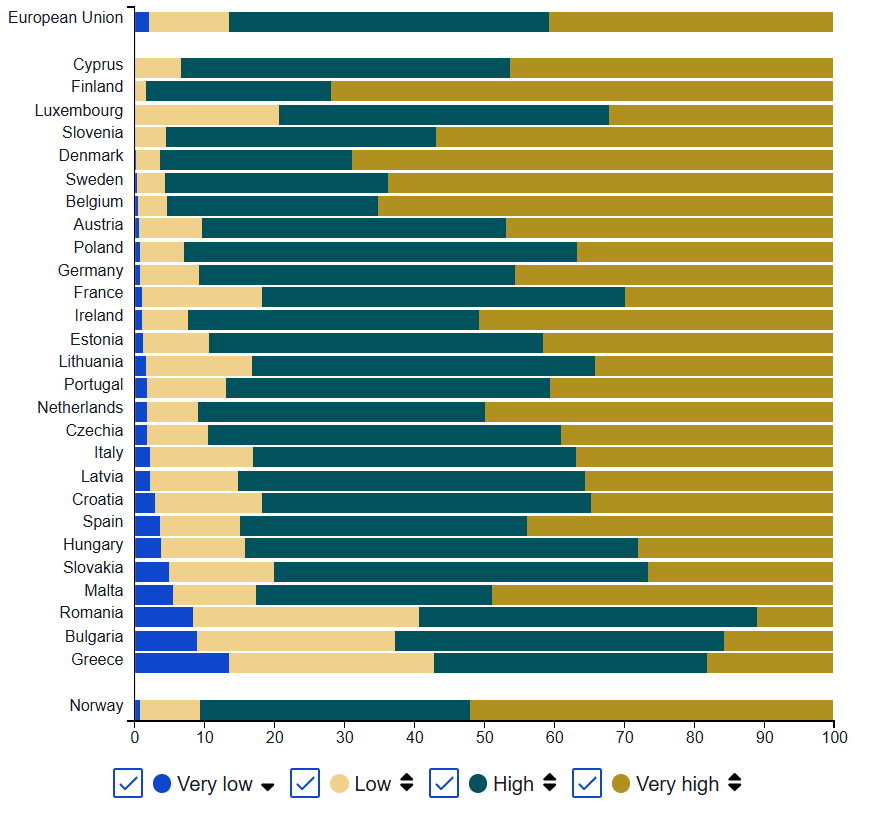
Source: Eurostat – Digital Intesity by size class of enterprise (2024)
AI and Excellence in Research
Finland’s AI ecosystem has grown rapidly in recent years. The number of companies utilising AI has multiplied over the past decade. The Research Institute of the Finnish Economy (ETLA) identified a total of 350 companies with at least five employees that developed or utilised AI in 2017 (ETLA 2019).
By 2019, this figure had grown to approximately 950 companies, and in 2020, AI accelerator FAIA estimated the number at 1,240 companies (FAIA 2020). Finland’s AI ecosystem particularly emphasises high-quality and internationally respected research. Finnish basic research, especially in the fields of machine learning and generative AI, is based on a strong academic tradition.
Finland took another significant step in research in May 2025 when the Finnish ELLIS Institute (European Laboratory for Learning and Intelligent Systems) was opened at Aalto University. It became the second institute in the Europe-wide AI network after Tübingen in Germany (Asikainen 2025).
The ELLIS Institute, coordinated by Aalto University, is a joint initiative by Finnish universities, supported by the Ministry of Education and Culture and the Foundation PS established by AMD Silo AI founder Peter Sarlin. The institute operates in close cooperation with 13 Finnish universities, including the University of Helsinki, Tampere University, University of Turku, University of Oulu and the National Defence University (Aalto University 2025; Alvarez & Forsberg 2025).
The ELLIS Institute brings together Finland’s best researchers and serves as a magnet for international talent. A special feature of the institutes is the close collaboration between academic research and industry. The €40 million funding from the public sector and €10 million donation from the private sector concretely demonstrate Finland’s commitment to investing in top talent and research (FCAI 2024).
Ecosystems and Europe
AI research conducted in Finland is supported by the country’s significant technological infrastructure. The flagship is the LUMI supercomputer located in Kajaani, one of the world’s most powerful computational resources. Supercomputers are particularly well-suited for processing large amounts of data and supporting AI-based research and applications across various industries.
The development of large language models (LLMs), such as ChatGPT or Claude, would not have been possible without supercomputers (Voutilainen 2024). LUMI acts as a kind of catalyst for research and development conducted in Finland.
Cooperation between the public, private and third sectors is seamless and non-hierarchical. This accelerates knowledge exchange and enables agile experimentation. The activities are supported by diverse centres of expertise, such as the Finnish Center for AI (FCAI), Technology Industries of Finland’s AI Finland and the recently established ELLIS Institute, which provide platforms for both cutting-edge research and international cooperation.
EU innovation programmes and European Digital Innovation Hubs (EDIHs) form a comprehensive service offering from preliminary assessments and needs analyses to expert services, development and testing environments, and financing services. The EDIH network connects 2,355 organisations in 225 centres, covering nearly 90% of European regions (Carpentier et al. 2025).
Four innovation hubs operate in Finland: Finnish AI Region (FAIR), Robocoast, HealthHub and Location Innovation Hub, which accelerate companies’ digital capabilities and competitive advantages across various sectors.
Finland's Appeal is Waning
Success is not self-evident. To remain competitive, Finland must continue to invest in AI expertise, infrastructure and investments. While there is abundant public funding available for early-stage AI companies, for example through Business Finland, large growth funding rounds are rare. This limits companies’ ability to scale and grow into global players.
The demand for AI specialists far exceeds supply, although the situation is still reasonable for now (AI Finland & Business Finland 2025). Finland attracts talent thanks to its good quality of life, security and stable, functioning society. However, exceptionally low salaries compared to competitor countries also weigh in the balance. Finland does not reach the top ten in lists measuring the mobility of foreign top talent and the attractiveness of different countries.
In InterNations’ annual Expat Insider survey, Finland’s reputation has collapsed. Finland dropped from 16th place to 51st place in 2024 (InterNations 2024). The survey includes a total of 53 countries. Although Finland received praise for its environment and digital services, the challenges faced by foreigners are greater than its strengths:
- Finding accommodation
- Learning the language
- High cost of living and low salaries
- Limited career opportunities
- Difficulty of social life
- Integration challenges
The International Experts in Finland study conducted by the Academic Engineers and Architechts in Finland (TEK) and the Union of Professional Engineers in Finland in 2024 provides similar indications. According to the survey, as many as 45% of technology and engineering professionals working in Finland felt they could not recommend Finland as an attractive and welcoming destination for foreign talent. Only 15% of respondents said they were ready to recommend Finland as a good career choice for professionals in these fields (TEK & UPEF 2024).
The situation is concerning given how important international talent flow is for the country’s innovation ecosystem. Patent statistics show that inventors with foreign backgrounds were involved in as many as 60% of patents by Finnish companies and research institutions in 2023 (O’Dwyer 2024).
Without foreign top specialists, Finland would not be able to achieve even its current level of innovation, let alone global leadership. This emphasises the need to keep Finland open and attractive to world-class talent.

Photo: Haaga-Helia University of Applied Sciences
The Investment Bottleneck
Finland also faces financing challenges. Whilst AI companies operating globally have received record investments last year and this year, development in Finland has been more modest, with the exception of Silo AI’s acquisition and Iceye’s funding rounds.
This is not about the attractiveness of Finnish companies, but a broader picture. The funding received by Finnish startups has been at a lower level than before in recent years and clearly behind comparable countries. Reasons cited include poor economic conditions and high interest rates (AI Finland & Business Finland 2025).
The problem is being addressed through public funding and other support offered, for example, through Business Finland, but this alone is not sufficient to compensate for the lack of international capital. Finland clearly lags behind its peers, such as Sweden, in attracting larger growth funding rounds.
Based on public sources, AI startups received approximately €50 million in funding in 2024 (AI Finland & Business Finland 2025). For comparison, globally, an AI startup targeting the international market can raise a similar sum in a single funding round.
Commercialising Innovations
Scientific expertise and technology development do not automatically translate into successful business. The commercialisation of innovations, and particularly marketing, is one of Finland’s pain points. Promising ideas and prototypes are constantly emerging, but few grow into global products or services under Finnish leadership.
Many inventions find practical application only after a foreign company buys the innovation or the startup is sold to international markets. The scarcity of funding directly affects the development of the Finnish ecosystem. Promising companies must be sold because Finland lacks sufficient resources to scale the business.
Silo AI’s sale for €614 million to chip giant AMD in 2024 is an excellent example of this (Cherney 2024). This is one of Europe’s largest AI sector acquisitions ever, and it demonstrates that Finland can produce significant AI players whose clients are global giants like Rolls-Royce, Philips and Unilever.
The commercialisation of innovations in Finland remains challenging – the path from research to market is often narrow and steep. Although encouraging examples exist, generally speaking, the connection between academic research and business needs strengthening.
Finland has strong and internationally recognised AI research in universities, but utilising this potential would require:
- More industry-led R&D centres
- Spin-off companies
- Global technology companies’ AI research units in Finland
This would harness academic excellence for domestic companies and create new business (AI Finland 2025).
Another commercialisation challenge relates to how Finnish companies use AI. In many established companies, AI is primarily used to improve processes, such as production optimisation or customer analytics, rather than developing entirely new AI-based products and services.
Whilst operational efficiency improves, radical, market-transforming innovations receive less attention. Startups have more courage to build completely new business models around AI, and they are encouraged to share their experiences with more traditional players.
Internationalisation is vital for Finnish companies due to the small domestic market, but it is also demanding. Success in global markets requires resources, market knowledge and risk tolerance – not all of which are always sufficiently available.
Investing Today for Tomorrow’s Success
From Finland’s perspective, it would be strategically important that an increasing number of AI innovations could be commercialised from Finland into international success. Success in this requires comprehensive investment:
- More research and development funding
- Stronger support for emerging companies
- Customer-focused experimentation culture
- Determined internationalisation supported by the state
In Finland, the public sector is a key enabler of AI development. The most nationally significant actor is Business Finland, which has funded numerous startups and research projects. For AI development, it is crucial whether the public sector succeeds in combining ethical responsibility and agile innovation support in a way that strengthens Finland’s competitiveness and international attractiveness.
However, the public sector has also been criticised for distorting competition due to its active role at the levels of funding, ecosystems and regulation. At its best, it can act as a catalyst by:
- Opening up data
- Providing testing environments
- Funding development
- Acting as the first customer
At the same time, it must avoid over-regulation and focus on implementation support and internationalisation, especially in the SME sector.
Summary
None of the challenges that have emerged are insurmountable. Many of them are strongly interconnected, meaning that one success can trigger a positive spiral. Finland has positioned itself strongly in AI development and application, both within a European and global context.
The country’s robust research tradition, high-quality education system, dynamic innovation landscape and advanced digital infrastructure form a solid foundation for technological growth. However, technical and academic expertise alone cannot guarantee success – what proves decisive is the ability to commercialise and scale innovations for international markets.
The scarcity of private investment and venture capital constrains the development of growth companies and their global competitiveness. Finnish research-driven innovations often remain underutilised in their full potential or end up in foreign hands before achieving commercial breakthrough. This weakens Finland’s prospects of maintaining its technological sovereignty in strategic sectors – artificial intelligence, quantum technology and cybersecurity.
Finland also grapples with skills shortages and attracting international specialists. Quality of life, safety and a well-functioning society make Finland an attractive destination in principle, but salary levels, linguistic barriers and limited career opportunities diminish its appeal amongst top talent.
The public sector’s role in AI development has been central, but it must be able to strike a balance between support and excessive regulation. Moving forward, it will be increasingly important for the state to act as an enabler, providing frameworks within which innovations can grow both agilely and ethically sustainably.
Finland must build a strong AI ecosystem where research, business and the public sector operate in seamless collaboration. Success in this endeavour will not only strengthen Finland’s position as a technology pioneer, but also secure the country’s economic competitiveness and prosperity well into the future.

Martti Asikainen
RDI Communications Specialist
+358 44 920 7374
martti.asikainen@haaga-helia.fi
References
Aalto University. (2025). Finland establishes ELLIS Institute to build new foundations for AI. Published 28.5.2025. https://www.aalto.fi/fi/uutiset/suomeen-perustettu-ellis-instituutti-rakentaa-tekoalyn-uusia-perusteita
AI Finland. (2025). The State of AI in Finland 2025: Growing ecosystem needs bold investments. Published 6.2.2025. https://aifinland.fi/tekoalyn-tila-suomessa-2025-kasvava-ekosysteemi-kaipaa-rohkeita-investointeja/
AI Finland & Business Finland. (2025). The State of AI in Finland 2025. Helsinki. https://tekoalyntilasuomessa.fi
Academic Engineers and Architects in Finland & The Union of Professional Engineers in Finland. (2024). International Experts in Finland. Survey results 2024.
Alvarez, A. & Forsberg, T. (2025). Machine learning brings revolution to research and product development. Aalto University. 17.6.2025.
Asikainen, M. (2025). Finland Launches ELLIS Institute as Europe’s Second Major AI Research Hub. Finnish AI Region. 11.6.2025.
Carpentier, E., D’Adda, D., Nepelski, D., & Stake, J. (2025). European Digital Innovation Hubs Network’s activities and customers. Publications Office of the European Union.
Cherney, A. M. (2024). AMD to acquire Finnish startup Silo AI for $665 mln to step up in AI race. Reuters. 10.7.2024.
Research Institute of the Finnish Economy ETLA. (2019). ETLA estimates: Number of companies utilising AI has doubled. 1.8.2019.
European Comission (2021). Finland
AI Strategy Report.
European Commission (2023). ANNEX to the Commission Recommendation on critical technology areas for the EU’s economic security. C(2023) 6689 final.
Eurostat (2024). Individuals’ level of digital skills (from 2021 onwards). 17.12.2024.
Eurostat. (2025a). Artificial intelligence by size class of enterprise. 9.4.2025.
Eurostat (2025b). Enterprises that provided training to develop/upgrade ICT skills. 11.2.2025.
Eurostat (2025c). Cloud computing services by size class of enterprise. 9.4.2025.
Eurostat (2025d). Employed ICT specialists – total. 15.4.2025.
Eurostat (2025e). Digital Intensity by size class of enterprise. 9.4.2025.
FAIA. (2020). State of AI in Finland. Helsinki.
FCAI. (2024). Strong investment in AI – ELLIS Institute to be established in Finland. 30.10.2024.
InterNations. (2024). Admiring Finland’s Beautiful Landscapes Comes at a Cost. https://www.internations.org/expat-insider/2024/finland-40460
Kristeri, T. (2025). Situation report on European Union and Finland’s economic security policy. National Emergency Supply Agency.
O’Dwyer, G. (2024). Fears tighter Finnish immigration laws could deter IT talent. Computer Weekly. 27.11.2024.
Silo AI & AI Finland. (2025). The Nordic State of AI – Report Edition IV. Helsinki.
Sitra, Technology Industries of Finland & VTT. (2025). Critical Digital Tech from Finland: Driving Growth and Security in Europe. Helsinki.
Stanford University Human-Centered AI Institute. (2024). The Global AI Vibrancy Tool.
Voutilainen, E. (2024). What is a supercomputer and why does it matter? Finnish AI Region. 4.11.2024.

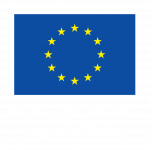
Finnish AI Region
2022-2025.
Media contacts